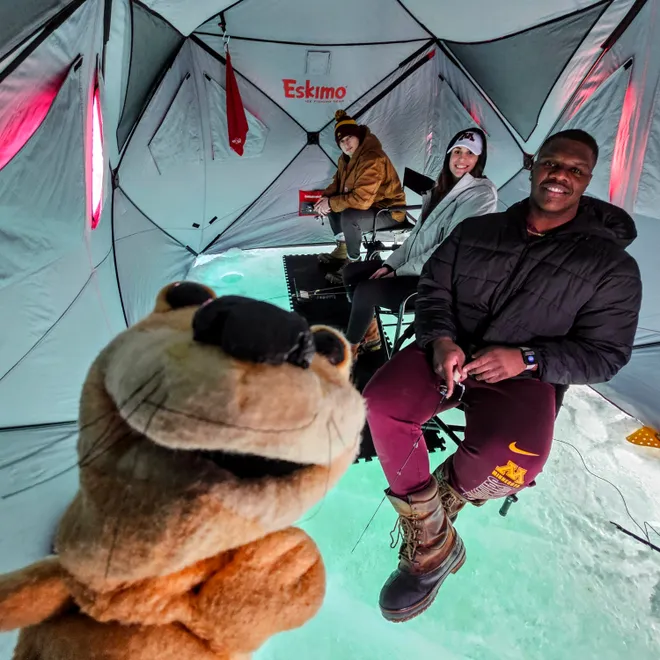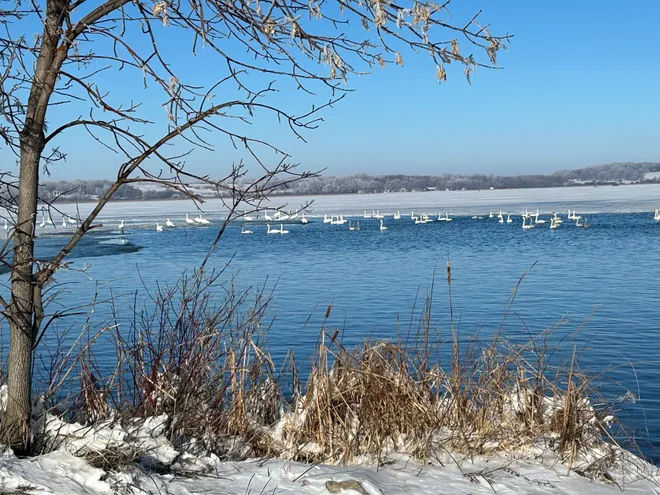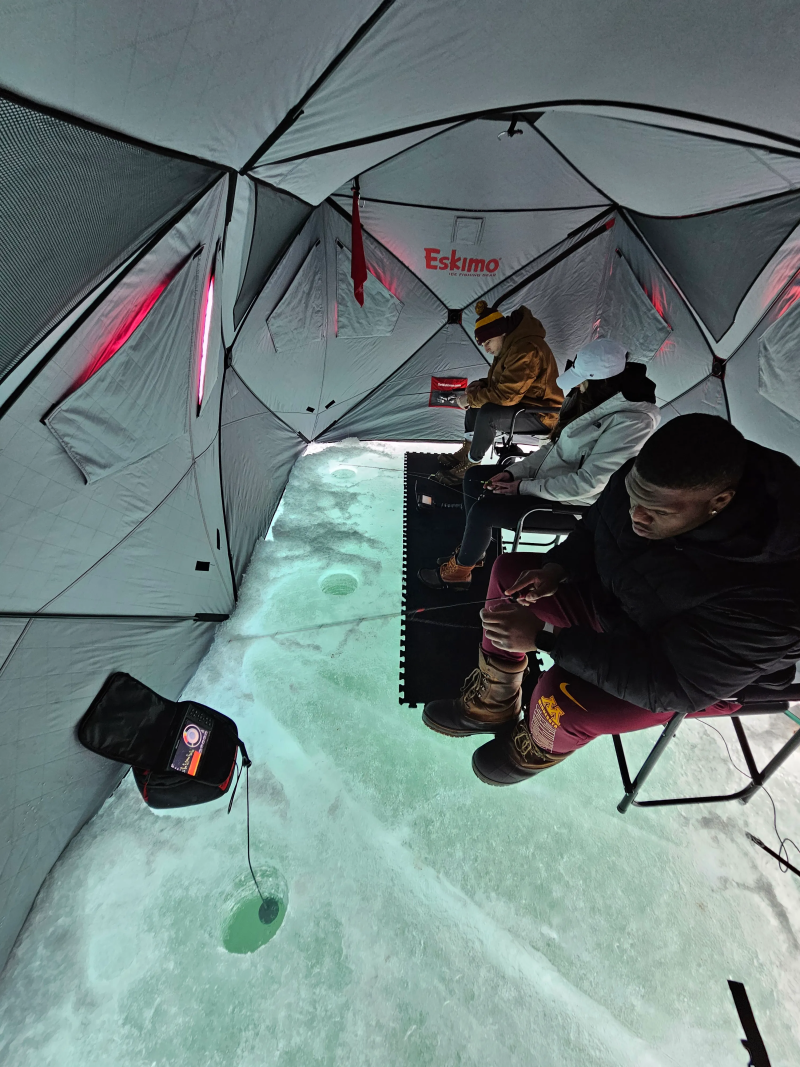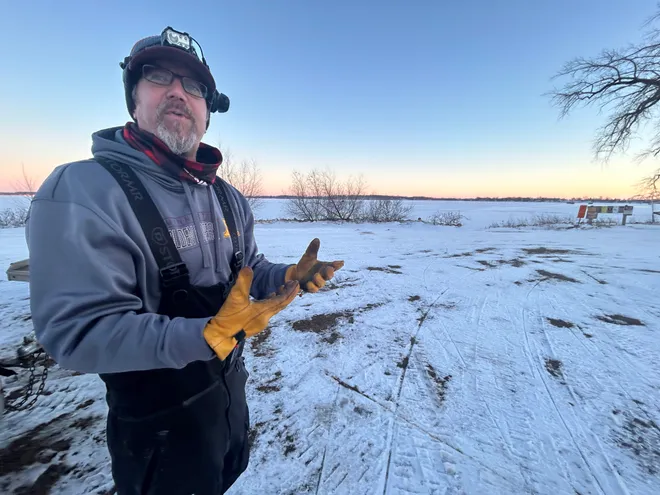To spur a rural rebound, one Minnesota county is paying college athletes to promote it

Max Brosmer is used to spending his Saturdays starring on turf, not ice. So the starting quarterback for the University of Minnesota was recently a bit out of his element on a frozen lake three hours from the Twin Cities.
Yet it was no accident that the Big Ten athlete ended up fishing on the ice here in February. He was paid to go. It’s part of an all-out charm offensive by Otter Tail County to introduce a new generation to rural life and, eventually, start replenishing its aging workforce.
In the last two years, Otter Tail has paid the quarterback and five other university athletes to post online about their experiences visiting the rural county, which boasts two state parks and 1,000 lakes.
“It was unbelievable,” Brosmer said in an interview after visiting Otter Tail. “I think people are missing out on that piece of life. There’s always so much going on in the city or a busy suburb, but being able to get away from that noise is really healthy and really helpful.”
Recruiting new talent is a matter of survival for Otter Tail and other rural counties across America that face population decline, labor shortages, and widening skill gaps.

While universities are sometimes seen as agents of brain drain, drawing away young talent who might not return, officials in Otter Tail think they can turn higher education into a catalyst for a new, long-term brain gain.
Let the 18-year-olds go, they say, but focus on laying the groundwork for talented graduates to move there later in their careers, when they may be ready to leave city hassles behind and raise their families somewhere more rural.
“There is one train of thought where the big university is the enemy and is stealing all our kids,” says rural rebound coordinator Erik Osberg, who led the county’s effort to strike partnerships with university athletes. “We’re saying, No, let’s find these college students, and invite them to come and experience rural life so they can form their own opinion of it.”
So far, Otter Tail has paid four football players and two volleyball players from the University of Minnesota between $500 and $5,000 each through “NIL” deals that allow college athletes to benefit from their name, image, and likeness. The NCAA changed its rules in 2021 to allow those kinds of payments.
In return, the county asks the athletes to share social media posts about their trips to the county, which have involved activities like boat rides and corn mazes.
When Brosmer came, the county planned a visit to the local hospital, Perham Health, since the gridiron star is also a master’s student studying kinesiology who plans to pursue medicine after his football days are done.

It surprised him, and dismantled preconceived notions. “When I was thinking of a rural hospital, I thought of a super small building, maybe not as technologically advanced,” he says. “Once I got there, it was gorgeous. A completely new hospital, in the shape of a huge canoe, absolutely unbelievable with a center center and a whole pharmacy.”
Changing perceptions is part of the point for Osberg, who treats each tour as “legit recruiting visits,” he says. “I am trying to roll out the red carpet for them and treat them like the star talent they are.”
Back in Minneapolis, Otter Tail is working to reshape narratives, too, thanks to a multi-year marketing deal the county signed with the University of Minnesota athletics department.
People attending a university hockey match or football game might now see the county’s Otter mascot palling around with his new university friend Goldy the Gopher.

And it’s not just athletes who get VIP treatment. Otter Tail employers hosted a pitch competition last year at a Minneapolis brewery near campus. They also bussed 14 business students out to lake country for a few days of fishing and touring local employers.
“If you look at the state of Minnesota, there is only one institution that produces 50,000 students a year. So if we’re trying to recruit a workforce, connecting with the largest producer of future employees is probably a good idea,” Osberg says.
To be clear, few people in Otter Tail expect that those students will immediately move to lake country upon graduation. Instead, its leaders hope that building fond associations with Otter Tail now could lead top talent to consider moving here in their thirties or forties.
Brosmer, for one, agrees the strategy could attract Gen Zers like him. “I think there’s been a shift. We’re in that period now where people in my generation are living in the cities. But as generations age, I believe it starts to fluctuate back,” he says.
Otter Tail’s strategy is rooted in research by Ben Winchester, a rural sociologist for the University of Minnesota Extension. In recent years, he has found that the biggest growth in rural populations has come from adults aged 30 to 49.
Mid-career professionals can help spur a rebound in rural communities, Winchester says. They bring with them education, work experience, professional contacts, and young families.
“You just have a different priority on your life once you hit your thirties,” Winchester says. “I’m not trying to sell this to 18-year-olds. Of course, you’re going to lose some of your kids. They need to see what else is out there in the world. My point is simple: Let them go, and let them know that if they want to come home, that is fine, too.”
In Otter Tail, Osberg’s unusual job title was created as a direct response to Winchester’s research. County commissioners decided in 2018 that aggressive action was needed after a state report suggested Otter Tail could lose up to 5% of its working-age population by 2030.
A drop like that would be devastating for a community that already had trouble filling key positions at its medical facilities and manufacturing companies, from smaller machine and auto repair shops to bigger food processing factories.
“That was the lightning bolt for our county commissioners to say that we needed to do something,” says Amy Baldwin, who serves as the county’s community development director.
Otter Tail treats tourism as a “first date” for wooing potential new residents. The community college hosts art exhibits and plays, while its lakes are dotted with large statues of otters, loons, and other critters.

Community-led festivals, like “Froze Fest,” paint an idyllic portrait of life in rural Minnesota. It’s an image Osberg reinforces by regularly sharing photos of sunsets and trophy fish on Instagram, as well as video interviews with urban transplants who have relocated to Otter Tail.
Still, all of that work is wasted if Otter Tail can’t create the infrastructure to support new residents once they come. “Attracting people with the marketing and the lifestyle doesn’t matter if they don’t have childcare, broadband, jobs, or a place to live,” says Baldwin, who moved her husband and kids from Minneapolis to Fergus Falls seeking a better quality of life over a decade ago, and is now charged with making sure others can do the same.
While Otter Tail’s natural beauty is one of its strengths, its many lakes have made expanding broadband access particularly expensive. The county has improved from its bottom-place ranking in recent years, but still ranks 69th out of 87 counties in connectivity.
Affordable housing is tough to come by, with median house sales prices in Otter Tail at around $303,000 in March, up 33% year-over-year, according to Redfin. That’s made the task of bringing in new workers even more difficult, Winchester says: “The line is around the block for people wanting to move to our rural areas. We just can’t find anywhere for them to live.”
It doesn’t help, county officials say, that a third of the county’s houses are summer homes, which families may hold onto for generations. Construction costs have risen so high that it doesn’t make sense for private companies to build new entry-level homes. That’s forced the county to step in: It’s starting by building six new homes, even though administrators know it might not be a long-term solution since they will likely have to sell each for a loss of $50K to $100K.

Still, Otter Tail has made some progress in adding childcare options, enlisting churches and employers to provide facilities that can pass state regulations that became stricter in recent years. Plus, the existing workforce gaps mean there are plenty of high-paying careers available for transplants willing to move to small towns like Perham, where there are far more jobs than people to work them.
In fact, across rural America, half of adults now have a job that pays at least middle-class wages, according to a recent Georgetown University report. That’s just a few percentage points below the 54% that do in urban areas, despite the perception that there are fewer opportunities outside the cities.
Osberg says that one of the most important ways rural communities can try to engineer their own growth is to shift their own narratives.
“Part of it is about getting rid of the negative self-talk: Nobody is going to move to your area because they feel sorry for you,” Osberg says. “Imagine if you were a football coach, and you told a recruit that the field is terrible, the facilities suck, and your players are awful. Do you think that athlete would still want to come?”
At the very least, Otter Tail’s efforts are keeping disaster at bay. The county’s percentage of working age adults has remained steady, a win for now, considering the decline that was predicted half a decade ago.
And there are glimmers of hope, coming from a new generation. Melani Shaffmaster, an All-Big Ten setter on the University of Minnesota’s volleyball team, has been asking about local summer internships since she visited last fall. “Found my inner otter,” the accounting and finance major posted on Instagram, smiling in front of a mural of lakes and loons.
Nick Fouriezos is a staff reporter forOpen Campus, a nonprofit newsroom focused on higher education, where he covers colleges’ role in rural America.
Disclaimer: The copyright of this article belongs to the original author. Reposting this article is solely for the purpose of information dissemination and does not constitute any investment advice. If there is any infringement, please contact us immediately. We will make corrections or deletions as necessary. Thank you.





